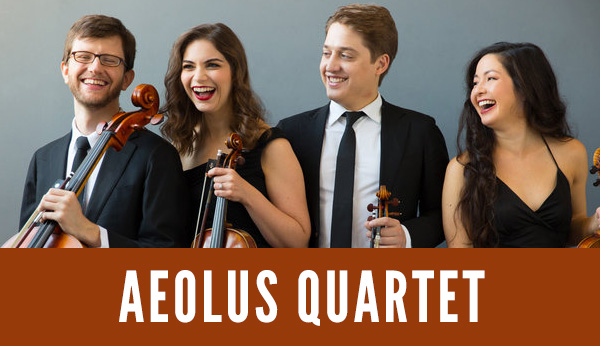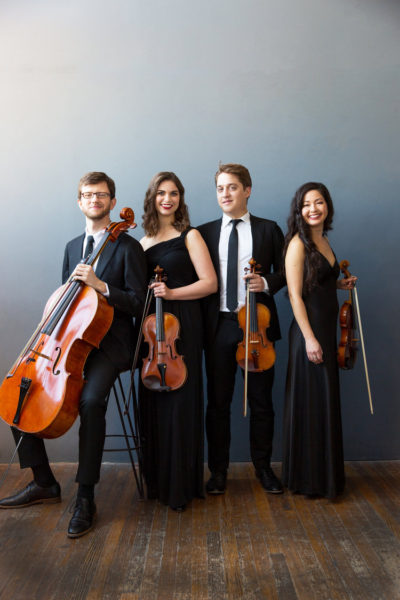AEOLUS QUARTET
Friday, June 11 | 7:30 PM
Our Saviour’s Lutheran Church
4102 N. Ben Jordan Street
JOHANN SEBASTIAN BACH (1685–1750)
Chorale No. 363, BWV 393 — “O Welt, sieh hier dein Leben”
Quartet in A Major, Op. 20 No. 6
- Allegro di Molto e Scherzando
- Adagio, Cantabile
- Minuetto. Allegretto
- Fuga a 3 Soggetti. Allegro
J.S. BACH
Chorale No. 26, BWV 20 — “O Ewigkeit, du Donnerwort”
GEORGE WALKER (1922 – 2018)
String Quartet No. 1, Lyric
2. Molto adagio
J.S. BACH
Chorale No. 20, BWV 80 — “Ein feste Burg ist unser Gott”
FELIX MENDELSSOHN (1809–1847)
String Quartet No. 6 in F minor, Op. 80
- Allegro vivace assai
- Allegro assai
- Adagio
- Finale: Allegro molto
Nicholas Tavani, violin
Rachel Shapiro, violin
Caitlin Lynch, viola
Jia Kim, cello

Sponsors

The Albert E. & Myrtle Gunn York Trust
Dr. James Grumman & Mrs. Janice Grumman
This concert is generously supported by our concert sponsors and by donors to the Victoria Bach Festival’s Annual Fund. Many thanks to our generous supporters!
J.S. Bach wrote about four hundred chorales, settings of Lutheran hymns in four-part harmony. The exquisite harmonization of these works, along with their brevity, has made them favorite warm-up exercises for orchestras and ensembles, including the Aeolus Quartet. The Quartet explains:
“We begin every quartet rehearsal the same way: by playing a Bach chorale. We do it for a multitude of reasons. First, we absolutely love them. We find them to be perfect gems—seemingly simple yet profound, they illuminate the unending magic of Bach’s harmonic genius. Second, they help us warm up together—as we play we work to deepen our listening, sharpen our awareness, strive for unity of sound, expand our color palette, react to harmony, fine-tune our group pitch … and ground ourselves in the present—almost like a meditation we embark upon together before we confront the complexities of whatever repertoire or project lies ahead.”
Beginning in June 2020 and continuing over the course of the pandemic, the Quartet recorded one of Bach’s chorales each week to “support and celebrate the strength and goodness of humanity coming together in the face of adversity.” To listen to their archived recordings and learn more about the Aeolus Quartet’s “Bach for All” project, visit www.aeolusquartet.com/bach-for-all.
Joseph Haydn is often recognized as the “father of the string quartet,” and his impact on the musical form is undeniable. Haydn must have been taken with the form, since he wrote a total of sixty-eight string quartets (by comparison, Mozart wrote twenty-three, and Beethoven only sixteen). Haydn’s output was remarkable, but so was the quality of his compositions and his influence on the string quartet’s structure and form.
Haydn wrote a series of six string quartets in 1772, when he was forty years old. The set’s nickname, the “Sun” quartets, came from the symbol printed on the first edition of the music, but the sixth quartet of Opus 20 is indeed sunny and bright. The first movement springs forth with energy and wit, followed by the slow movement’s lovely lullaby. The minuet is light and enchanting while the finale offers a lively fugue. The sense of both perfect balance and delightful surprise in Haydn’s musical lines demonstrate his well-deserved designation as “father of the string quartet.”
American composer George Walker wrote his first string quartet in 1946, when he was twenty-four. The quartet’s second movement became the basis of Walker’s most popular work, his “Lyric for Strings” for string orchestra (to be performed by the VBF String Orchestra on Saturday, June 12).
Walker wrote of the “Lyric for Strings:”
“It was composed in 1946 and was originally the second movement of my first string quartet. After a brief introduction, the principal theme that permeates the entire work is introduced by the first violins. A static interlude is followed by successive imitations of the theme that leads to an intense climax. The final section of the work presents a somewhat more animated statement of the same thematic material. The coda recalls the quiet interlude that appeared earlier. The Lyric for Strings is dedicated to the memory of my grandmother.”
The String Quartet No. 6 in F minor was among Felix Mendelssohn‘s last compositions, and was published posthumously. He wrote it while on medically-ordered rest in Interlaken, Switzerland as prescribed by his physician following a collapse. Mendelssohn had been overwhelmed with emotion upon learning of the death of his collaborator and sister, Fanny Mendelssohn. Fanny was overcome by a sudden stroke on May 14, 1847, while rehearsing a concert. The String Quartet No. 6 bears the title “Requiem for Fanny.”
Mendelssohn poured his grief into his composition. The first two movements of the quartet are filled with anguish and unease. The third movement offers a nostalgic pause, a tender portrait of a beloved sister. The final movement is unrelenting and jarring, marked by stabbing syncopations.
Just a few months later, on November 4, 1847, Mendelssohn himself died from a paralytic stroke at the age of thirty-eight. This final quartet, written during a period of mental and physical exhaustion, is a moving and passionate musical expression of Mendelssohn’s grief and suffering.
Sun and Sorrow in the String Quartet
J.S. Bach wrote about four hundred chorales, settings of Lutheran hymns in four-part harmony. The exquisite harmonization of these works, along with their brevity, has made them favorite warm-up exercises for orchestras and ensembles, including the Aeolus Quartet. The Quartet explains:
“We begin every quartet rehearsal the same way: by playing a Bach chorale. We do it for a multitude of reasons. First, we absolutely love them. We find them to be perfect gems—seemingly simple yet profound, they illuminate the unending magic of Bach’s harmonic genius. Second, they help us warm up together—as we play we work to deepen our listening, sharpen our awareness, strive for unity of sound, expand our color palette, react to harmony, fine-tune our group pitch … and ground ourselves in the present—almost like a meditation we embark upon together before we confront the complexities of whatever repertoire or project lies ahead.”
Beginning in June 2020 and continuing over the course of the pandemic, the Quartet recorded one of Bach’s chorales each week to “support and celebrate the strength and goodness of humanity coming together in the face of adversity.” To listen to their archived recordings and learn more about the Aeolus Quartet’s “Bach for All” project, visit www.aeolusquartet.com/bach-for-all.
Joseph Haydn is often recognized as the “father of the string quartet,” and his impact on the musical form is undeniable. Haydn must have been taken with the form, since he wrote a total of sixty-eight string quartets (by comparison, Mozart wrote twenty-three, and Beethoven only sixteen). Haydn’s output was remarkable, but so was the quality of his compositions and his influence on the string quartet’s structure and form.
Haydn wrote a series of six string quartets in 1772, when he was forty years old. The set’s nickname, the “Sun” quartets, came from the symbol printed on the first edition of the music, but the sixth quartet of Opus 20 is indeed sunny and bright. The first movement springs forth with energy and wit, followed by the slow movement’s lovely lullaby. The minuet is light and enchanting while the finale offers a lively fugue. The sense of both perfect balance and delightful surprise in Haydn’s musical lines demonstrate his well-deserved designation as “father of the string quartet.”
American composer George Walker wrote his first string quartet in 1946, when he was twenty-four. The quartet’s second movement became the basis of Walker’s most popular work, his “Lyric for Strings” for string orchestra (to be performed by the VBF String Orchestra on Saturday, June 12).
Walker wrote of the “Lyric for Strings:”
“It was composed in 1946 and was originally the second movement of my first string quartet. After a brief introduction, the principal theme that permeates the entire work is introduced by the first violins. A static interlude is followed by successive imitations of the theme that leads to an intense climax. The final section of the work presents a somewhat more animated statement of the same thematic material. The coda recalls the quiet interlude that appeared earlier. The Lyric for Strings is dedicated to the memory of my grandmother.”
The String Quartet No. 6 in F minor was among Felix Mendelssohn‘s last compositions, and was published posthumously. He wrote it while on medically-ordered rest in Interlaken, Switzerland as prescribed by his physician following a collapse. Mendelssohn had been overwhelmed with emotion upon learning of the death of his collaborator and sister, Fanny Mendelssohn. Fanny was overcome by a sudden stroke on May 14, 1847, while rehearsing a concert. The String Quartet No. 6 bears the title “Requiem for Fanny.”
Mendelssohn poured his grief into his composition. The first two movements of the quartet are filled with anguish and unease. The third movement offers a nostalgic pause, a tender portrait of a beloved sister. The final movement is unrelenting and jarring, marked by stabbing syncopations.
Just a few months later, on November 4, 1847, Mendelssohn himself died from a paralytic stroke at the age of thirty-eight. This final quartet, written during a period of mental and physical exhaustion, is a moving and passionate musical expression of Mendelssohn’s grief and suffering.
About the Artists

Praised by the Baltimore Sun for combining “smoothly meshed technique with a sense of spontaneity and discovery,” the Aeolus Quartet is committed to presenting both time-seasoned masterworks and new cutting-edge works to widely diverse audiences with equal freshness, dedication, and fervor. Formed in 2008, the Quartet is comprised of violinists Nicholas Tavani and Rachel Shapiro, violist Caitlin Lynch, and cellist Alan Richardson. The Aeolus Quartet has been awarded prizes at nearly every major competition in the United States and performed across the globe with showings “worthy of a major-league quartet” (Scott Cantrell, Dallas Morning News). Mark Satola of the Cleveland Plain Dealer writes, “The quartet has a rich and warm tone combined with precise ensemble playing (that managed also to come across as fluid and natural), and an impressive musical intelligence guided every technical and dramatic turn.” They were the 2013-2015 Graduate Resident String Quartet at the Juilliard School, and they currently make their home in New York City.
In addition to extensive touring throughout the United States in the 2019-2020 season, the Quartet will be featured at the Artosphere Festival hosted by the Walton Arts Center, as well as in the premiere of a new chamber opera at NYC’s Prototype Festival. They will appear in concert at Cornell University, the Austin Chamber Music Festival, the Santa Barbara Museum of Art, and NYC’s Bohemian National Hall, among others.
The Aeolus Quartet has released two critically acclaimed albums of classical and contemporary works through the Longhorn/Naxos label which are available on iTunes, Amazon, and major retailers worldwide. Part of an ongoing series entitled Many-Sided Music, these albums promote the diversity and breadth of works by American composers. The next album in the Many-Sided Music series is slated for release in Spring 2020.
The Aeolus Quartet’s numerous honors include Grand Prize at both the Plowman Chamber Music Competition and the Chamber Music Yellow Springs Competition, as well as First Prize at the Coleman International Chamber Ensemble Competition. They were also prizewinners at the Fischoff International Chamber Music Competition and the International Chamber Music Ensemble Competition in New England. The Austin Critics’ Table named the Aeolus Quartet their 2016-17 “Best Touring Performance” for Rambunctious, a collaboration with Spectrum Dance Theater.
The Quartet has performed across North America, Europe, and Asia in venues such as Alice Tully Hall, Weill Recital Hall at Carnegie Hall, Reinberger Recital Hall at Severance Hall, The Library of Congress, Renwick Gallery, St. Martin-in-the-Fields, and the Shanghai Oriental Arts Center. In addition, the quartet was recently featured on the hit Netflix show The Defenders.
Dedicated to sharing the joy of chamber music with audiences new to classical music, the Aeolus Quartet has been widely recognized for their highly creative and engaging outreach programs. In the 2015-2016 season, the Quartet was the recipient of a CMA Residency Partnership Grant. In recognition of the Aeolus Quartet’s artistic achievement, CMA awarded the project with the title of “Guarneri Quartet Residency” for 2016. The residency promoted engagement with multiple interactive performances at Duke Ellington School for the Arts, the Sitar Arts Center, and George Washington University. The Fischoff National Chamber Music Association awarded the Quartet their 2013 Educator Award in acknowledgment of the positive impact their educational efforts have had in diverse communities. Additionally, they were awarded the 2012 Lad Prize which culminated in large-scale community engagement work, performing in the Stanford area, and a masterclass residency at Stanford University. The Aeolus Quartet has also served as teaching faculty at Stanford University’s Education Program for Gifted Youth (EPGY), the Austin Chamber Music Workshop, Point CounterPoint, and the Chloe Trevor Music Academy. Working in collaboration with the University of Texas through the Rural Chamber Music Outreach Initiative, the Quartet has presented educational programs and performances in communities throughout the state of Texas. Through their multiple residencies with the Chamber Music Society of Detroit alone, the Aeolus Quartet has reached over 18,000 students in the greater Detroit metro area.
The Aeolus Quartet has been fortunate to collaborate with many of today’s leading artists, including Renee Fleming, Ida Kavafian, Joel Krosnick, Peter Wiley, Michael Tree, and Paul Neubauer. They studied extensively with the Juilliard, Guarneri, St. Lawrence, Cavani, and Miró Quartets. Other mentors include Peter Salaff, Donald Weilerstein, Itzhak Perlman, and Mark Steinberg. Members of the Quartet hold degrees from the Juilliard School, the Cleveland Institute of Music, the University of Maryland, and the University of Texas at Austin.
The Aeolus Quartet is the ensemble-in-residence with Musica Viva NY and the New Orchestra of Washington (DC). Thanks to the generosity of the Five Partners Foundation, the four members play on a set of instruments by famed Brooklyn luthier Samuel Zygmuntowicz. The Quartet is named for the Greek god Aeolus, who governed the four winds. This idea of a single spirit uniting four individual forces serves as an inspiration to the members of the Aeolus Quartet as they pursue their craft.
See our full 2021 artist list for additional biographical information.



